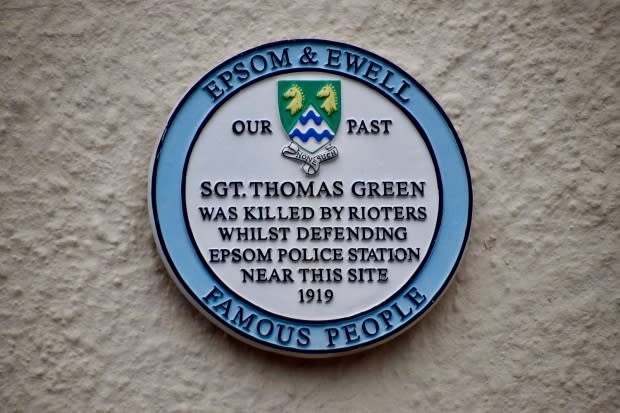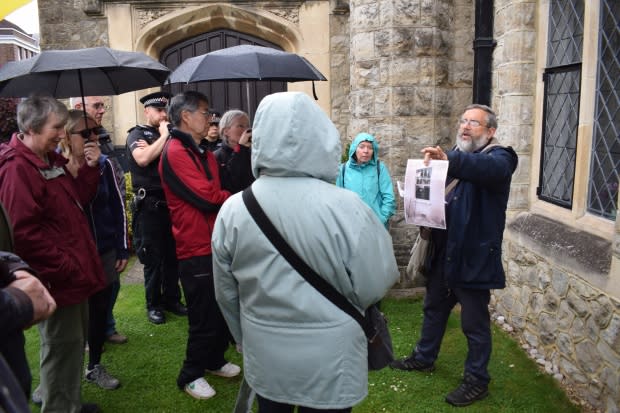A 'stain on the fair name of our soldiers': Remembering a Canadian riot that turned deadly in England in 1919

On a nondescript, white building in suburban Epsom, England, a round plaque serves as the only indicator of the wild and brutal scene witnessed on this street corner a century ago.
"Sgt. Thomas Green was killed by rioters whilst defending Epsom police station near this site," the blue and white plaque reads.
Left unsaid is that the rioters were Canadian soldiers — likely fuelled by booze and post-war stress — and that a royal intervention seemingly allowed them to avoid conviction for Green's death.
The Epsom riot on June 17, 1919, has come to be regarded as a tragic consequence of the uncertainty and anxiety the Canadians felt as they waited to be sent back home.
Seven months after the First World War armistice, the soldiers were still posted 20 kilometres south of London. Some were recovering at the Woodcote Park convalescent camp.
Dealing with physical and mental battle scars, many had little to do but to "hit the bar and get drunk," said Green's great-grandson, David Kirkham.

Kirkham has travelled to Epsom for the first time to mark 100 years since the killing. He's being taken on a tour retracing the steps of the Canadian soldiers that fateful night.
"It was just a series of events that led tragically to my great-grandfather's death," he told CBC.
A buildup of tension
Before the chaos began to snowball, Canadian servicemen were having their pints at The Rifleman, an Epsom pub still in operation today.
A scuffle at the bar led to two soldiers being arrested and held at the nearby police station. Friction between Canadians and local men meant the foreign soldiers showed little patience for British law enforcement.
"There was a lot of bad feeling," said David Brooks, an assistant at Epsom's Bourne Hall Museum.

Not only were the soldiers anxious to leave Britain, Brooks said, but British men were also fed up with seeing the Canadians charm local women.
The tension came to a head that night in June 1919.
An estimated 400 Canadian soldiers stormed the police station to free their two comrades. They threw rocks, busted windows and attempted to set the building on fire.
The two Canadian inmates were freed, but at a heavy cost.

Several police officers guarding the station were injured. Green, 51, was hit in the head with an iron prison cell bar and later died.
"It strictly was manslaughter," not premeditated murder, Kirkham said. "It was the heat of the moment."
Still, the attack came as an embarrassment for Canadian forces, who'd fought alongside British troops and become known for boldness on the battlefields of Vimy Ridge and Passchendaele.
An Ottawa Citizen headline in June 1919 called the riot a "stain on the fair name of our soldiers."
A royal intervention?
Eight rioters were charged with manslaughter in connection with Green's death but none was convicted. Four were sentenced to a year behind bars for rioting. They were all freed within weeks.
In his 2010 book about the riot, We Are Not Manslaughterers, Epsom-based author Martin Knight concludes a forthcoming royal tour likely played a part in the lenient sentencing.

Edward, Prince of Wales, was due to visit Canada a year after the war — only two months after the riot erupted.
"They couldn't contemplate the thought of him touring those places if some Canadian soldiers were possibly going to be hanged or sentenced to life in prison," Knight told CBC.
Winston Churchill, then Britain's secretary of state for war, hesitated to call the act a killing, choosing instead to say Green had "died as a result of his injuries."
'I have to confess'
In his book, Knight recounts a Cape Breton-born blacksmith-turned soldier, Allan McMaster, shouted "Let's go, boys!" as he led the Canadians to charge the police station.
Years later in Winnipeg, McMaster would confess to wielding the iron bar that killed Green.
"The reason I make this statement is because I feel a burden on my conscience and know I have to confess," McMaster told police in 1929.

He said he had been pardoned by the Prince of Wales.
Canadian authorities notified Scotland Yard of the confession, but were told the case was closed.
McMaster's medical records, obtained through Library and Archives Canada, note he "wouldn't trust himself" and "has often done things unconsciously in [a] part-epileptic state."
His grandson and others blame post-traumatic stress disorder for McMaster's frantic actions that day.

"I have no doubt in my mind that he was back in the trenches" when fighting at the police station, Ric deMeulles said in a telephone interview from his home in Sudbury, Ont.
"The violence is abhorrent to me, but I have deep sympathy for a man who was grossly injured" during the war.
McMaster went on to take his own life in 1939.
100 years later
Commemorations are being held this week to remember Green, both at The Rifleman Pub and at the Epsom cemetery where he's buried near Canadian soldiers.
Green's family didn't hold a grudge against Canada — his two daughters married Canadians.
"They came over, they wanted a fresh start," said Green's great-grandson Kirkham, who was born in Toronto and lives in Victoria.
Watch Green's great-grandson present Green's medals
Last week in a small ceremony at the Epsom town hall, he donated Green's service medals so they can put on display at the local museum.
Kirkham also intends to sample the limited-edition beer on tap at The Rifleman, the Sgt. Green Bitter.
"I would hope that he'd be proud that people have kept the memory alive, that he wasn't forgotten."


